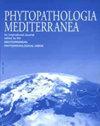一种隐白粉病(Golovinomyces hieraciorum sp. 11 .)发生在菊科(hieracitae)和毛囊(Pilosella)上
IF 1.9
3区 农林科学
Q2 AGRONOMY
引用次数: 1
摘要
环孢歌洛温酵母复合体在形态上高度可变,并在包括Hieracium spp.和Lapsana commons在内的多种菊科植物上引起白粉菌。2013年发表的一项关于戈洛温酵母的全面系统发育分析显示,环孢G.cichoracearum s.str.仅限于Scorzonera和Tragopogon spp.作为宿主(菊科、乳科、Scorzonerinae亚族)。为了阐明在亚洲和欧洲常见的Hieracium spp.(菊科、乳科、Hieracinae亚族)上的戈洛温酵母的系统发育和分类学,对Hieracim spp.和Lapsana commons的57个白粉菌标本进行了ITS+28S rDNA序列的形态学和系统发育分析。Hieracium spp.上的戈洛温酵母。在亚洲和欧洲,以前被称为G.cichoracearum,是一个以前未描述的隐蔽物种,在这里被描述为戈洛温菌。新的。由于从瑞士Lapsana consus上的一个白粉菌中检索到的序列与G.hieraciorum分支处于姐妹位置,目前的检查中包括了许多被鉴定为环孢G.cichoracearum的德国标本。所有重新检查的L.commons上的“G.cichoracearum”集合都被误认,并被证明属于Neoërysiphe nevoi或Podosphaera ergerontis canadensis。本文章由计算机程序翻译,如有差异,请以英文原文为准。
A cryptic powdery mildew (Golovinomyces hieraciorum sp. nov.) on Hieracium and Pilosella (Compositae)
The Golovinomyces cichoracearum complex is morphologically highly variable and causes powdery mildew on a wide range of Compositae, including Hieracium spp. and Lapsana communis. A comprehensive phylogenetic analysis of Golovinomyces, published in 2013, revealed that G. cichoracearum s. str. was confined to Scorzonera and Tragopogon spp. as hosts (Compositae, tribe Lactuceae, subtribe Scorzonerinae). To clarify the phylogeny and taxonomy of Golovinomyces on Hieracium spp. (Compositae, tribe Lactuceae, subtribe Hieraciinae), which is common in Asia and Europe, morphology and phylogenetic analyses of ITS + 28S rDNA sequences were conducted for 57 powdery mildew specimens of Hieracium spp. and Lapsana communis. Golovinomyces on Hieracium spp. in Asia and Europe, previously referred to as G. cichoracearum, is a previously undescribed, cryptic species, which is described here as Golovinomyces hieraciorum sp. nov.. Since a sequence retrieved from a powdery mildew on Lapsana communis in Switzerland clustered in sister position to the G. hieraciorum clade, numerous German specimens identified as G. cichoracearum were included in the present examinations. All the re-examined collections of “G. cichoracearum” on L. communis were misidentified, and were shown to belong to Neoërysiphe nevoi or Podosphaera ergerontis-canadensis.
求助全文
通过发布文献求助,成功后即可免费获取论文全文。
去求助
来源期刊

Phytopathologia Mediterranea
生物-植物科学
CiteScore
4.40
自引率
8.30%
发文量
28
审稿时长
6-12 weeks
期刊介绍:
Phytopathologia Mediterranea is an international journal edited by the Mediterranean Phytopathological Union. The journal’s mission is the promotion of plant health for Mediterranean crops, climate and regions, safe food production, and the transfer of new knowledge on plant diseases and their sustainable management.
The journal deals with all areas of plant pathology, including etiology, epidemiology, disease control, biochemical and physiological aspects, and utilization of molecular technologies. All types of plant pathogens are covered, including fungi, oomycetes, nematodes, protozoa, bacteria, phytoplasmas, viruses, and viroids. The journal also gives a special attention to research on mycotoxins, biological and integrated management of plant diseases, and the use of natural substances in disease and weed control. The journal focuses on pathology of Mediterranean crops grown throughout the world.
The Editorial Board of Phytopathologia Mediterranea has recently been reorganised, under two Editors-in-Chief and with an increased number of editors.
 求助内容:
求助内容: 应助结果提醒方式:
应助结果提醒方式:


